
Redwood Safari
I met Douglas Long, the Chief Curator of Natural Sciences at the Oakland Museum of California, in front of The Planet, J.B. Blunk's 1969 redwood burl sculpture that stands before the museum's Natural Science gallery.
The gallery is closed for construction until 2012, and today the burl looks a lot like a Christo sculpture—wrapped in blue shipping blankets and yellow caution-tape, its covering at once describes and occludes the shape that forms it.
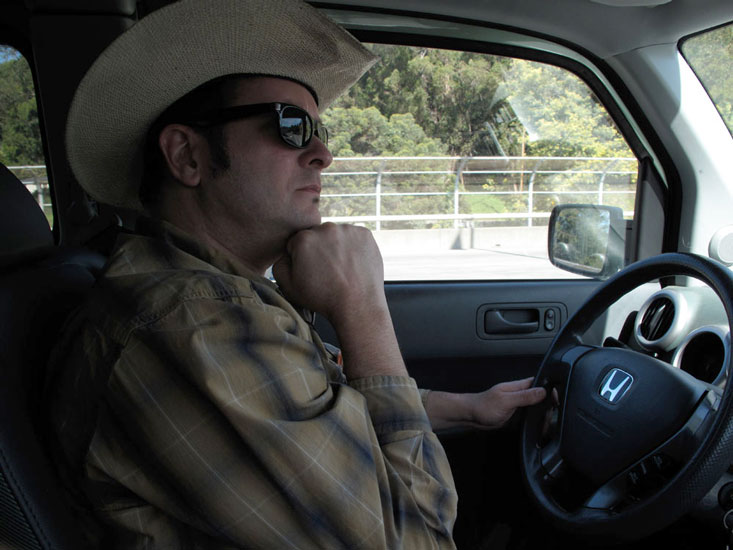
Curator Douglas Long en route to Leona Heights.
Douglas wore sunglasses and a Mexican cowboy hat. We had plans to drive from the museum to Leona Heights Park, across from Merritt College, in search of an old-growth redwood he'd spotted from a distance a few weeks earlier. As he explained in an email:
The new Natural Sciences gallery will feature seven real locations in California, each of them reflecting the geology, climate, topography, biodiversity, and conservation issues that comprise them. The gallery's first location will be Oakland, where we will feature the many diverse biological communities and habitats this city still has. One of these habitats is the unique redwood forest in the Oakland Hills, which was completely logged by the 1850s. There has been a persistent rumor of a single surviving old-growth that was spared the loggers' axes and saws, but this seemed to be more of a legend. Yesterday, I was on a reconnaissance mission with Todd Keeler-Wolf, the head vegetation specialist for the California Department of Fish & Game, to explore the current second- and third-growth redwood groves for evidence of any of these past giants, such as stumps of the long-gone, 2,000-plus-year-old trees. Late in the day, from a ridge high atop a steep valley, we think we spotted that last remaining giant old-growth redwood tree. Todd plans to hike to the tree and make some measurements and documentation, and has invited us to join him.
Coming face-to-face with the single remaining tree of a bygone primeval forest? Andrew, what do you think?
I thought it sounded excellent. We walked to his car, which had a whale skull in the back seat. Douglas's job at the museum encapsulates all aspects of California ecology, but he's unapologetic about being a self-described "critter guy." He pointed out the redwoods on the left side of the highway, and the oaks on the right, and then interrupted himself to identify some roadkill as he swerved around it: "Skunk—no, a possum."
When we got to Leona Heights, the museum's associate curator of aquatic biology, Christopher Richard, was waiting for us. In addition to studying the ocean, Christopher is, according to Douglas, "deeply rooted" in botany. He wore an engineer cap, and I began to feel concerned that I wasn't wearing a festive hat like they were. A few minutes later, Todd Keeler-Wolf arrived, quite hatlessly. Keeler-Wolf is by all accounts one of California's top vegetation specialists: in addition to serving as the senior vegetation ecologist at the California Department of Fish and Game, he's also the program director of the California Native Plant Society's vegetation program, and has published several books on the subject.
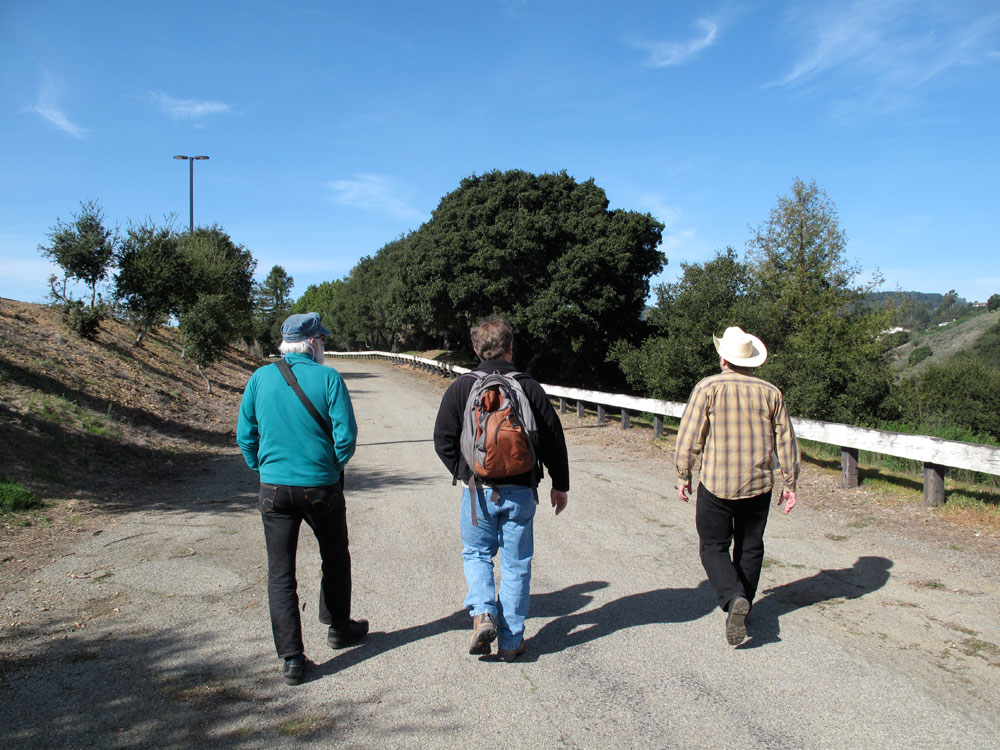
Christopher, Todd, and Douglas embark on the trail.
We began walking the York trail, stopping every few minutes to identify and admire another plant specimen. I'm used to walking through nature with English majors; we tend to hustle and trudge between milestones with our heads down, looking up only at vista points and water breaks. Life scientists, on the other hand, walk trails the way art historians wander through galleries, pausing again and again to marvel at each specimen, noting the salient features.
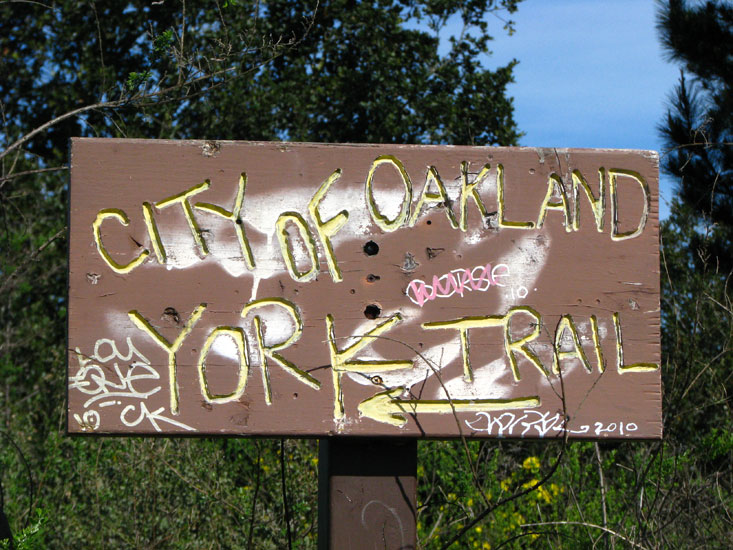
Much of the hill along the trail was covered in French Broom, an aggressive alien imported from Europe in the nineteenth century. Todd, Douglas, and Christopher—who, though they are distinguished scientists, I will collectively refer to as The Dudes—pointed out coyote brush and some massive acacia plants. Douglas, being a critter guy, noted that the acacia leaves would make a fine snack for a giraffe, should one find its way into Leona Heights. Tadpoles appeared in a pond. Todd wondered what ever happened to the Western toad, which The Dudes had seen a lot of as children, but not so much anymore. A brief silence followed this moment of toad-nostalgia. Douglas found a woodrat nest.
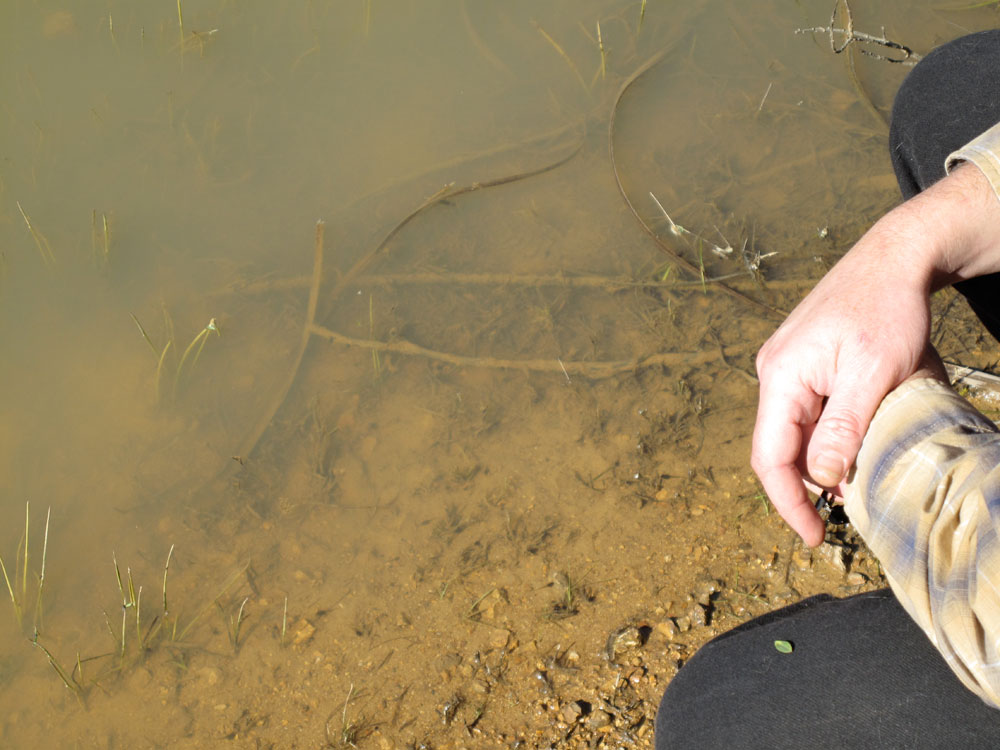
Douglas summons tadpoles.
Christopher's favorite fern is the goldback, which, when slapped against one's jeans, leaves a little fern-shaped tattoo from the smashed residue of the yellow spores that grow on the frond's back. Maidenhair and Polypodium were identified. Osoberries, in the rose family, usually grow farther north, but Todd found a bush growing in its southern limits. Osoberries are edible, and taste like stoneless cherries. We didn't eat any.
Christopher handed me a California bay leaf. You can cook with fresh bay leaves, I learned—you just use fewer of them. We also saw toothwort, which is so called because American Indians rubbed it on their teeth when they were in pain. Douglas handed me a California bay leaf. "I already gave him one," Christopher said.
We identified a thatch of purple-spotted poison hemlock. Socrates was executed by being made to drink a hemlock-based beverage more than 2,400 years ago; Todd told a story of a teenager who came close to unintentionally executing himself in the same way. We saw Snowberries. Redwood trees rose above the creek. "This is not old redwood," Keeler-Wolf said. He quoted William P. Gibbons's 1855 observation of the Oakland Hills as a "sea of stumps" after the large-scale logging of the old-growth San Antonio redwood forest. As we approached the site of the possible last remaining old-growth redwood that survived that clear-cutting, Douglas expressed some concern about our disclosing its exact location. Would people come and climb it, or carve initials and mottoes into it?
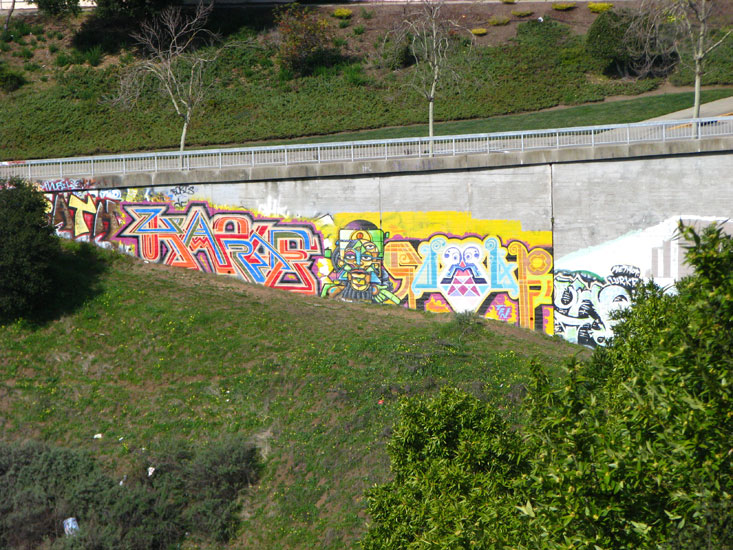
A view from across the canyon.
Coming around a bend, the monster old-growth redwood appeared on the horizon. Despite the fact that it was located a few dozen yards down a steep hill, its crown still towered above the canopy. The descent to the tree looked too steep to manage. It seemed more of a "free-fall" than a "butt-slide," and reservations were expressed. I felt relief. Christopher identified a psychedelic wild cucumber. Then Todd said he'd found a way he thought we could descend. Poison oak abounded. To get down the incline, you would sort of teeter, tumble, and surf down skittering tides of loose scree until a live oak came into reach; then you'd hug that for a while. Then you continued falling. The medulla of my adrenal gland probably started synthesizing some adrenaline at this point. After a few more minutes of scree-teetering, we crossed a deer trail and found ourselves at the base of the tree we were looking for.
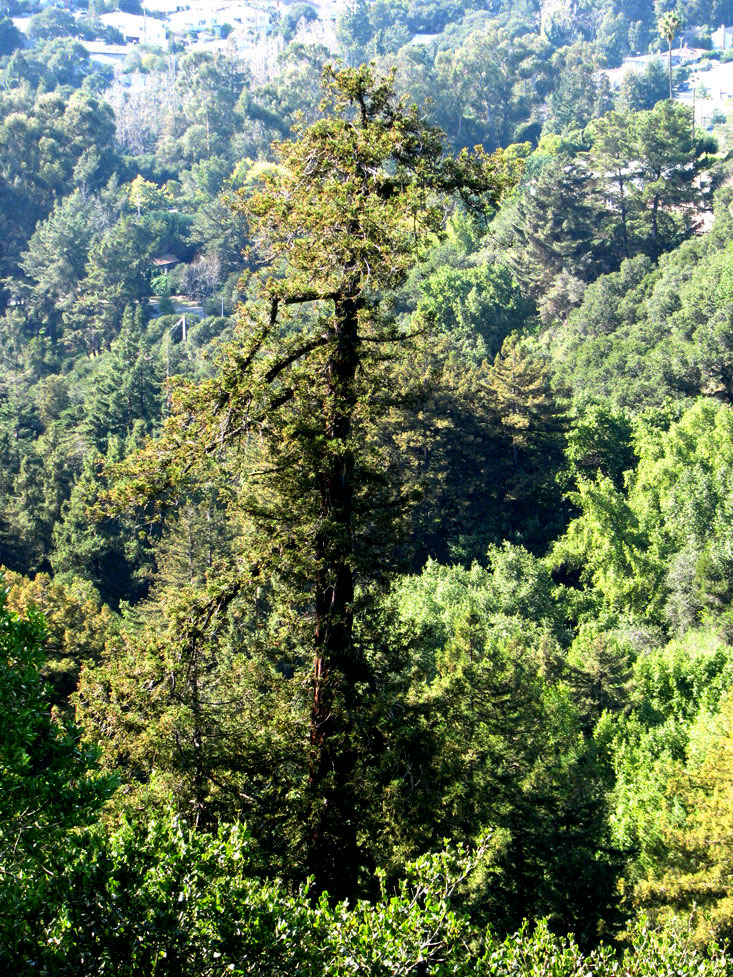
The monster old-growth redwood.

The descent.
Webs covered the folds of the bark. These cobwebs (belonging to funnel spiders, Douglas said) gave the tree a spooky, ghostly vibe that at the same time reminded one that the tree still lived, was a source of life.
"I thought all old-growth redwoods had tunnels you could drive your model A through," Christopher said. The Dudes chuckled, then agreed: this was the oldest living organism in the East Bay. They estimated it was over five hundred years old — though it could be twice that. They'd need a core sample to know for sure. The tree had probably survived for so long because it was growing in such a difficult place, surrounded by rocks on a steep incline.
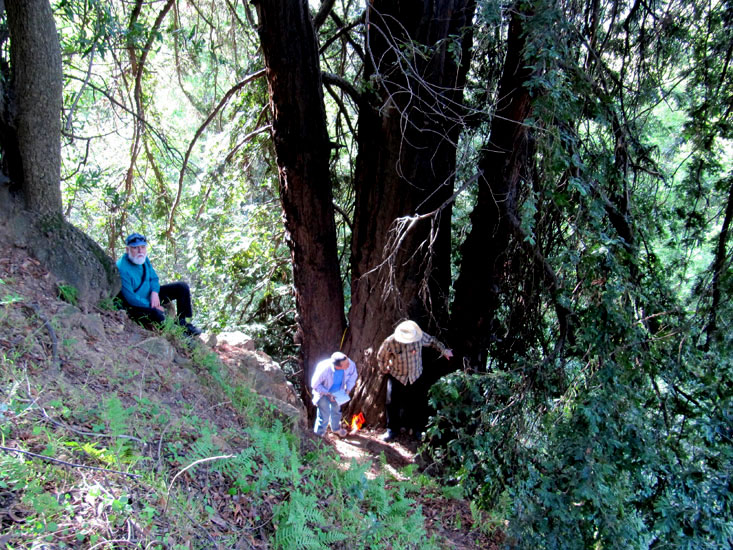
The tree looked beaten up: There was evidence of someone who'd taken a single hack at its trunk, and it had burn scars going all the way up. There was an area where its heartwood was exposed. It had probably burned every ten to twenty years, Todd said, going back hundreds of years. During fires, burning logs may have rolled down the hill and crashed into the tree. This sort of dangerous event may have been what inspired the tree to sprout, in an effort of self-preservation, two additional side stems from its base. Douglas found evidence of what may have been a bobcat sharpening its claws on a tree next to our old-growth redwood.
Todd tossed his fiberglass measuring tape around the tree's central trunk, where it fell down the steep incline on the other side. He descended and disappeared around the back of the tree, scrambling down then climbing up around its other side, bringing the tape with him to get his measurement.
To find the tree's height, Todd made his way about twenty yards across the slope. He sighted the tree's crown through his clinometer, then sighted its base. He was then able to triangulate the height of the tree. At first he estimated 21 meters. Everyone seemed disappointed. Thinking for a moment, Christopher and Douglas called out: "Twenty-one meters doesn't sound quite right."
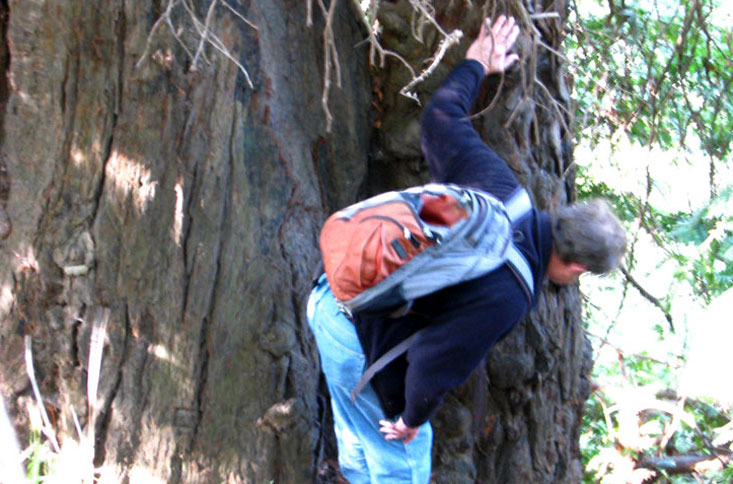
Todd performing the sniff test.
Todd called back that he'd try again. Sure enough, his calculation had been thwarted by trees caught in his sight-line. Trying again, he calculated 29.5 meters, which got a better reaction from the other Dudes. "It's always important to perform the sniff test," Christopher said.
Getting back up to the trail was significantly more difficult than the descent. The ground disappeared beneath one's feet. I clutched helplessly to the roots of plants above me, trying to drag myself up the hill using only my arms. I had a vision of myself lying on a couch, covered in poison oak rashes and white gauze, watching a soap opera on a small television. (This never happened.) We made it back to the trail. On the walk home, Douglas spotted a few band-tailed pigeons and slender salamanders. The only other people we saw were accompanied by packs of eight or nine dogs each—the park is intensely popular with professional dogwalkers.
Photographs by Christopher Richard and Todd Keeler-Wolf.
Projects








